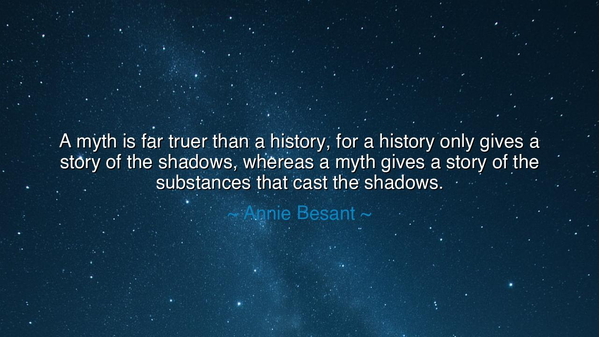
A myth is far truer than a history, for a history only gives a
A myth is far truer than a history, for a history only gives a story of the shadows, whereas a myth gives a story of the substances that cast the shadows.






“A myth is far truer than a history, for a history only gives a story of the shadows, whereas a myth gives a story of the substances that cast the shadows.” – Annie Besant
Thus spoke Annie Besant, the philosopher, reformer, and mystic who sought to uncover the divine essence within humanity and the hidden wisdom beneath the surface of the world. In this profound reflection, she lifts the veil that separates myth from history, declaring that while history records the shadows of human deeds — the events, the wars, the kings, and the laws — myth reveals the substance behind them: the eternal truths, the spiritual forces, and the cosmic patterns that shape human destiny. For Besant, myth is not falsehood, as the ignorant believe, but deeper truth clothed in symbol. History tells us what men did; myth tells us why they did it, and what it meant in the language of the soul.
The origin of this quote lies in Besant’s life among seekers of ancient wisdom. As a leader in the Theosophical Society, she delved into the scriptures and myths of India, Egypt, and Greece, discerning in them not superstition, but revelation. Where the historian sees invention, Besant saw spiritual allegory — the attempt of early humanity to express eternal truths in the language of story. For her, myth was the bridge between the mortal and the divine, a mirror through which the inner world of consciousness could be seen reflected in the outer world of form. Just as the shadow moves when the light shifts, so history changes with time; but the substance — the truth that casts that shadow — endures forever.
To say that myth is truer than history is to understand that facts alone cannot hold the fullness of human meaning. The historian may tell us that Troy was besieged, but only the myth of the Iliad tells us of the pride of Achilles, the grief of Hector, and the wrath of gods who mirror the passions of men. The myth is not concerned with dates or measurements; it speaks instead to the eternal struggle between honor and fate, between mortal frailty and divine will. Thus, myth is not less real — it is more real, because it reveals the invisible forces that history can only hint at.
Consider the story of Prometheus, the titan who stole fire from the gods to give it to mankind. To the historian, there was no Prometheus — only the gradual discovery of fire by early humans. Yet, to the philosopher and poet, Prometheus is the very symbol of human aspiration, the courage to defy the heavens in pursuit of knowledge. His punishment — bound to the rock, his liver devoured by an eagle each day — is the eternal reminder that enlightenment comes with suffering. The myth, in this way, speaks of truths beyond time: that creation requires sacrifice, that progress demands pain, and that every act of rebellion for light carries the risk of darkness. These truths cannot be captured by historical record, for they belong not to the chronicles of man, but to the soul of mankind.
Besant’s wisdom also teaches that history is temporal, while myth is archetypal. History is a river that flows endlessly, changing course as it goes, while myth is the mountain from which the river springs — the unmoving source, eternal and pure. History tells of kingdoms that rise and fall; myth tells of the cycle of life, death, and rebirth that underlies every empire and every age. The historian writes of rulers and armies; the mythmaker speaks of heroes and gods, who are but the reflections of our own higher and lower natures. In myth, we meet ourselves in divine disguise.
Yet, Besant does not call us to abandon history, but to see through it. For if history shows us the movement of shadows, myth teaches us to trace those shadows back to their source — the eternal light of truth that casts them. When we read of ancient myths or sacred stories, we should not ask, “Did this happen?” but rather, “What truth does this reveal?” The wise do not scorn the old tales; they listen to them with the inner ear, hearing the heartbeat of wisdom within their symbols.
So, my child of the modern age, take this teaching into your soul: seek the substance behind the shadow. Read history to understand the world, but read myth to understand yourself. Do not dismiss the old stories as fantasy, for they are the dreams of humanity, and dreams often speak truths that waking eyes cannot see. In the myths of gods, heroes, and monsters lies the reflection of your own struggles — your longing for light, your battle with darkness, your endless transformation. For as Annie Besant reminds us, myth tells the story of what is eternal in man, while history only records what is fleeting. And if you learn to see with both eyes — one upon the shadow, the other upon the light — then you will walk in wisdom, guided by the eternal truths that neither time nor memory can erase.






AAdministratorAdministrator
Welcome, honored guests. Please leave a comment, we will respond soon